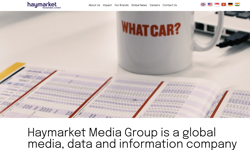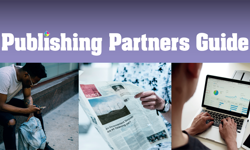After four years at the helm of a successful national freely distributed magazine that has a hold on its target market, where do you go next? Retail? To quote the woman of the year, Little Britain’s Vicky Pollard – no, but yeah, but no, but yeah – but no! My dreams and ambitions to take the UK’s largest circulating gay magazine, Bent, to the mainstream market seemed very lucrative on paper but the reality soon became clear after the fourth issue went on sale. What follows are the trials and tribulations of a small publisher discovering that retail circulation is not necessarily as profitable as having a free distribution.
Background
First of all … some background. When I started working for what was to become Bent, in the summer of 2001, we were called NowUK, which was an abbreviation of North of Watford; a previous incarnation. The magazine was 68 pages, distribution was national to over 500 gay venues with a print run generally of 60,000 copies. However, it transpired that some venues we dropped off at were no longer open, whilst some were even ditching the magazine when it was delivered! The cost of producing the magazine was covered by advertising and internal marketing through our parent company, All Points North, who also operate chat lines and mail order amongst a conglomerate of businesses that includes 118 Gay directory enquiries and the Mr Gay UK competition.
The content of the magazine was a retrospective of events on the gay scene, advertising was minimal and limited to bars and clubs; the "wow" factor was non-existent. The advertising manager at the time described the magazine as only being good to line the kitty litter tray! I had a tough time ahead of me!
Flash forward to the end of 2004. With the same number of staff, we had rebranded, revenue had tripled and the magazine is now 132 pages. Display and classified advertising has reached outside the predictable gay market. The winning formula of A-list celebrities, entertainment previews and comprehensive what’s on listings was working. Staff morale was high. The only problem we had was we couldn’t satisfy the market demand for Bent. We could only print so many copies with the revenue we were generating. Our loyal readership was struggling to regularly obtain a copy; many venues would run out of stock within days of delivery. It was time to think of how to make the title available to more people.
Alongside our free distribution, having a better quality version on sale in newsstands seemed to be the best option available. This way, Bent could be available to any consumer who wanted it and they would pay, in turn creating another revenue stream. Meanwhile media buyers would also see us in a superior light. I put the tender out to the distribution companies I sourced from the back of PPA’s Magazine News. Eventually I decided upon a company that looked after small niche titles and had many titles in WH Smith – where Bent wanted to be. They seemed the best to handle our launch and were enthusiastic about our chances of success. I also took on a freelance circulation manager. In creating these relationships I was relying on these "experts" to guide me through launching Bent at retail. The remit was slow, organic growth that would pay for itself. After months of meetings, we decided on a soft launch, backed by a low cost PR campaign utilising our internal resources. What transpired was a different story.
The consultant promised, and failed, to deliver numerous free-of-charge distribution deals. A month before launch I finally realised that the distribution company and consultant had failed in their tasks to secure the maximum number of outlets for the budget we set. However the decision was made to get the magazine out there anyway. A new consultant was hired and the distribution company pulled out all the stops to make sure Bent would find good shelves to be sold from.
We had already publicly promoted the launch date and the editorial and advertising was good to go. To help drive sales, we cut back our free distribution, introduced a Bent loyalty card to the paid-for version – whereby consumers could get discount entry into clubs and bars – thereby they could recoup the money spent buying Bent when going out. We also gave away a free CD with the retail launch issue. On Thursday 28th April, Bent was available to buy for the first time on the newsstand.
Encouraging start
The first indication that going retail was going to pay off came from the initial Epos report. This came in and, whilst below my expectations, the distributor was enthused and optimistic. In turn I became so. At this point the staff at Bent, and the market place in general, was excited by the product – it looked like the risk was going to pay off. Unfortunately I was wrong.
The money spent on buying shelf space was only just being recouped. Media buyers were slowly but surely becoming interested in placing Bent on their advertising schedules. Meanwhile, the distribution company argued that we were doing well enough to commit to a promotional spend to further drive sales. Added value extras to help the magazine sell more copies (like free posters, varnished cover and agency-bought photographs) were also becoming a cost we could do without.
Suddenly, slow, low cost organic growth was turning into an expensive operation. The new circulation manager provided a spreadsheet that highlighted where spend could be made and where return on investment was possible. On paper it looked like further promotional spend was the way to go. However our other revenue streams were becoming affected. With fewer copies distributed freely, the revenue-making marketing activity was beginning to suffer. The scales were being tipped.
Retreat
Unfortunately, the costs involved in retail were numerous and some unexpected. There was the carriage, increased editorial costs, increased production costs, promotional expenses, buying shelf space, paying for an external consultant to help etc etc. On top of this there was the increased stress placed on the staff committed to achieving retail success. The labour of love was someway rewarded by the final product looking amazing but eventually, if the cash doesn’t follow, it is all in vain.
After testing Bent in the retail market for six issues and receiving feedback from our regular advertisers and readers, the decision was made to keep Bent solely in the free market and increase this distribution. Our aim was to reach as many gay people in the UK as possible and, if this is more easily achieved by giving it away, then that is what we must do.
For a small publisher, the bottom line is that profitability is vital for survival. Regrettably, with the outlay of human time, promotional expenses, technical resources and the ever-increasing costs associated with buying your way into the retail market it is very difficult to achieve a profitable return in a short period. Lessons learnt are plenty.
Other routes to market
If increasing the visibility and availability of your magazine is the aim, explore and exhaust other methods first. Try subscriptions, down-grade the quality of your magazine to increase your print-run, create a downloadable version from the web. While retail does have a certain appeal to many publishers, it is not necessarily the most lucrative approach. For Bent, we are much happier, financially, in the free market. We have our market that picks Bent up and takes it home. They respond to advertisements – we know this though our marketing ads. Our website – bent.com – is now attracting as big an audience as our magazine. For our clubs, bars and classified advertisers, as well as media buyers, Bent is able to reach a bigger audience, making us more viable to them.
Our problem with supplying the market has been solved through other channels. For anyone who regularly wants a copy of Bent, they can subscribe via a revolutionary SMS service that reverse bills them each month or they can go to www.bent.com/subscribe and manage their subscription online. If they are not willing to pay they can always download a PDF version from Bent.com.
Going retail may be the way forward for some titles. Indeed there is an independent political magazine, Diplo, produced in the same building as Bent who receive very little advertising revenue and rely on sales to fund themselves. They have seen year-on-year sales increase dramatically and are continually adding new retail outlets. However, I would advise any publisher considering entering the market to have a good hard think as to whether this is going to best serve their aims and ambitions.
| What to watch out for when going retail * Is your magazine really suitable for the retail market? * Who will buy it and how will you let them know you are on sale? * Know what your budget is and stick to it. * Obtain professional references if using a third-party circulation manager. Interview more than one and pick the best. Budget for at least £500 a month for a part-timer. * Receive weekly briefings from the circulation manager so you know he is doing his job. * Hold regular meetings with your distribution company and circulation manager. * Set out a time line of activity. * Make sure the person at the distribution company is someone you are happy dealing with. * Speak to other publishers about their distribution channels. * Find out if the distribution company is willing to put up their own money towards paying for placement with wholesalers. * Don’t just speak to the bigger distribution companies, give the smaller distribution companies a look in too — working with fewer titles they may give yours more time. |










